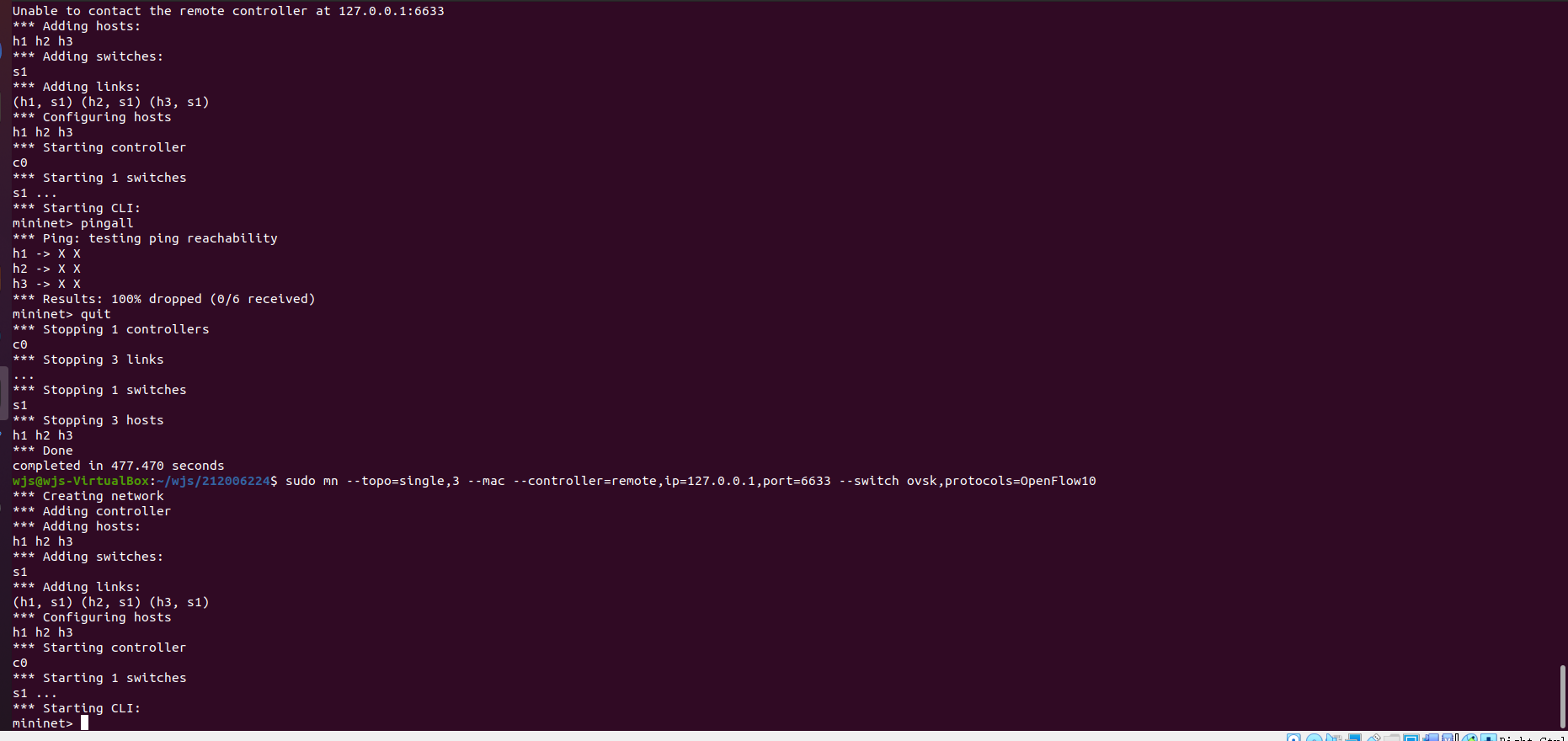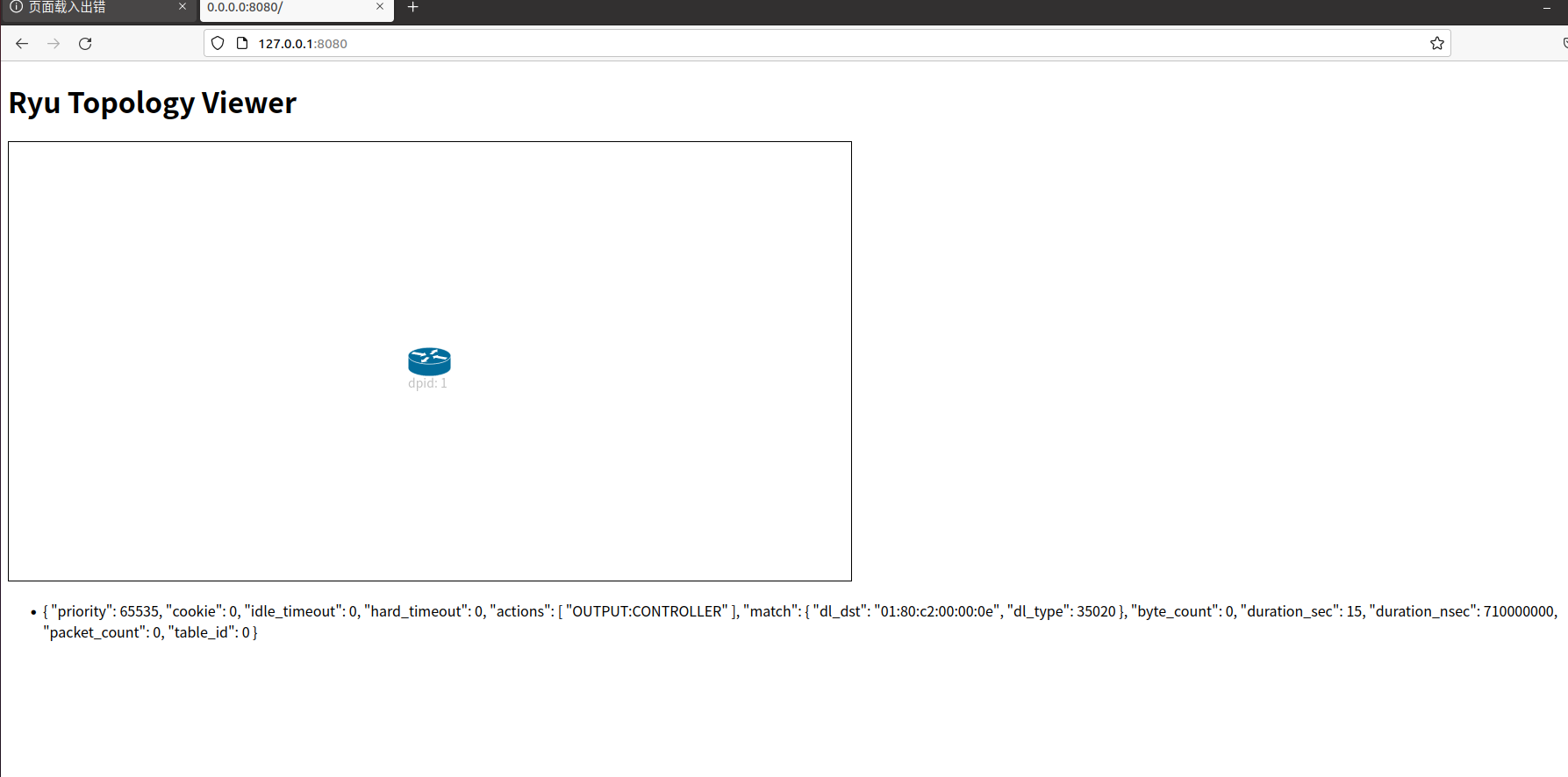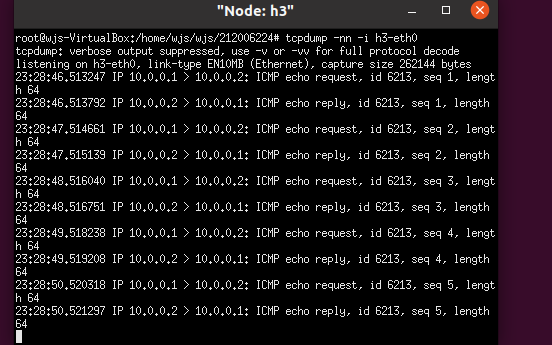1.搭建下图所示SDN拓扑,协议使用Open Flow 1.0,并连接Ryu控制器,通过Ryu的图形界面查看网络拓扑。

输入命令生成拓扑 sudo mn --topo=single,3 --mac --controller=remote,ip=127.0.0.1,port=6633 --switch ovsk,protocols=OpenFlow10

输入命令开启ryu控制器 ryu-manager ryu/ryu/app/gui_topology/gui_topology.py --observe-links

通过Ryu的图形界面查看网络拓扑

2.阅读Ryu文档的The First Application一节,运行当中的L2Switch,h1 ping h2或h3,在目标主机使用 tcpdump 验证L2Switch,分析L2Switch和POX的Hub模块有何不同。
阅读了The First Application写出来了L2Switch.py
L2Switch.py代码为
from ryu.base import app_manager from ryu.controller import ofp_event from ryu.controller.handler import MAIN_DISPATCHER from ryu.controller.handler import set_ev_cls from ryu.ofproto import ofproto_v1_0 class L2Switch(app_manager.RyuApp): OFP_VERSIONS = [ofproto_v1_0.OFP_VERSION] def __init__(self, *args, **kwargs): super(L2Switch, self).__init__(*args, **kwargs) @set_ev_cls(ofp_event.EventOFPPacketIn, MAIN_DISPATCHER) def packet_in_handler(self, ev): msg = ev.msg dp = msg.datapath ofp = dp.ofproto ofp_parser = dp.ofproto_parser actions = [ofp_parser.OFPActionOutput(ofp.OFPP_FLOOD)] data = None if msg.buffer_id == ofp.OFP_NO_BUFFER: data = msg.data out = ofp_parser.OFPPacketOut( datapath=dp, buffer_id=msg.buffer_id, in_port=msg.in_port, actions=actions, data = data) dp.send_msg(out)
然后运行L2Switch
输入以下命令 L2Switch ryu-manager L2Switch.py

在mininet 打开终端
输入命令为 xterm h1 h2 h3
在输入命令
h1 ping h2
在h2输入命令
tcpdump -nn -i h3-eth0
在h3输入命令
tcpdump -nn -i h3-eth0

如图为h2终端

如图为h3终端
3.编程修改L2Switch.py,另存为L2xxxxxxxxx.py,使之和POX的Hub模块的变得一致?(xxxxxxxxx为学号)
修改L2xxxxxxxxx.py的代码为
from ryu.base import app_manager from ryu.controller import ofp_event from ryu.controller.handler import MAIN_DISPATCHER, CONFIG_DISPATCHER from ryu.controller.handler import set_ev_cls from ryu.ofproto import ofproto_v1_3 #openflow版本:1.3(1.3才支持config协议) #定义一个类L2Switch,继承app_manager,位于ryu下的base内,版本选择openflow1.3,然后初始化操作。 class L2Switch(app_manager.RyuApp): OFP_VERSIONS = [ofproto_v1_3.OFP_VERSION] #定义改成v1_3版本 #类的初始化函数 def __init__(self, *args, **kwargs): super(L2Switch, self).__init__(*args, **kwargs) #在Ryu控制器上,要写一个函数去处理openvswitch的连接 @set_ev_cls(ofp_event.EventOFPSwitchFeatures, CONFIG_DISPATCHER) def switch_feathers_handler(self, ev): #解析数据 #datapath像数据平面的通道,等同于网桥 dp = ev.msg.datapath ofp = dp.ofproto #版本 ofp_parser = dp.ofproto_parser #基于此版本的一些库类 #接收到交换机的连接后,要下发一条tableentrys,一个默认的流表,来指挥所有匹配不到交换机的数据,将其上传到控制器 #install the table miss flow entry,即在ryu控制器里安装流表项 #匹配域 match = ofp_parser.OFPMatch() #动作域:OFPActionOutPut将数据包发送出去 #第一个参数:发送端口:控制器(把那些没有匹配的东西给控制器) #第二个参数:数据包在交换机上缓存buffer_id,由于将数据包全部传送到控制器,所以不在交换机上缓存 actions = [ofp_parser.OFPActionOutput(ofp.OFPP_CONTROLLER, ofp.OFPCML_NO_BUFFER)] self.add_flow(dp, 0, match, actions) #为了提高代码重用,对于添加流表,单独写一个函数。 def add_flow(self, datapath, priority, match, actions): #add a flow entry and install it into datapath # 1\ datapath for the switch, 2\priority for flow entry, 3\match field, 4\action for packet ofp = dp.ofproto ofp_parser = dp.ofproto_parser #交换机中需要有指令 # install flow # construct a flow_mod msg and sent it inst = [ofp_parser.OFPInstructionActions(ofp.OFPIT_APPLY_ACTIONS, actions)] mod = ofp_parser.OFPFlowMod(datapath=dp, priority=priority, match=match, instructions=inst) dp.send_msg(mod) #需要定义packet in函数,用来处理交换机和控制器之间的流表交互,在执行之前要先对packetin事件进行监听。 @set_ev_cls(ofp_event.EventOFPPacketIn, MAIN_DISPATCHER) #MAIN_DISPATCHER:主状态下监听事件 def packet_in_handler(self, ev): #数据解析 msg = ev.msg dp= msg.datapath ofp= dp.ofproto ofp_parser = dp.ofproto_parser in_port = msg.match['msg.in_port']#match匹配域中提取in_port #发送出去(通过加一个流表) #construct a flow entry match = ofp_parser.OFPMatch() #匹配项为空,因为所有取到的内容都要泛洪出去 actions = [ofp_parser.OFPActionOutput(ofproto.OFPP_FLOOD)]#泛洪动作 #调用添加流表的函数,把流表发送出去 # install flow mode to avoid match in next time self.add_flow(datapath, 1, match, actions) #处理当下的pack_in,将其发出 #buffer_id是一个很重要的参数,因为数据包进入交换机,要有地方暂存,到了取的时候就需要有对应的id来指定 # to output the current packet. for install rules only output later packets out = ofp_parser.OFPPacketOut(datapath=dp, buffer_id=msg.buffer_id, in_port=msg.in_port, actions=actions, data = data) # buffer id: locate the buffered packet dp.send_msg(out)
生成拓扑为
sudo mn --topo=single,3 --mac --controller=remote,ip=127.0.0.1,port=6633 --switch ovsk
然后打开控制器命令为
ryu-manager L2*********.py
在生成的拓扑写下
dpctl dump-flows

来验证修改的成果
2.进阶要求
相关问题回答
a.代码当中的mac_to_port的作用是什么?
mac地址到交换机端口的映射
b.simple_switch和simple_switch_13在dpid的输出上有何不同?
simple_switch是直接输出dpid,而simple_switch_13是在dpid前端填充0直至满16位。
c.相比simple_switch,simple_switch_13增加的switch_feature_handler实现了什么功能?
实现了交换机以特性应答消息去响应特性请求
d.simple_switch_13是如何实现流规则下发的?
在接收到packetin事件后,首先获取包学习,交换机信息,以太网信息,协议信息等等。如果以太网类型是 LLDP类型,则不予处理。否则,获取源端口的目的端口和交换机的id,先学习源地址对应的交换机的入端口,再查看是否已经学习目的mac地址。如果没有则进行洪泛转发,否则为学习过该mac地址,那就查看是否有buffer_id,有则在添加流表信息动作时加上buffer_id,向交换机发送流表。
e.switch_features_handler和_packet_in_handler两个事件在发送流规则的优先级上有何不同?
switch_features_handler下发流表的优先级比_packet_in_handler高。
个人总结:
实验一开始sudo mn --topo=single,3 --mac --controller=remote,ip=127.0.0.1,port=6633 --switch ovsk,protocols=OpenFlow10这样在输入dpctl dump-flows没有任何效果,因为协议出现冲突。所以要修改一下命令,输入这个命令sudo mn --topo=single,3 --mac --controller=remote,ip=127.0.0.1,port=6633 --switch ovskRyu 是一个基于 python 的开源网络操作系统,Ryu 目的在于提供逻辑上的集中化管理,通过提供 API 使网络管理更加方便,Ryu 支持 openflow 1.1,并且已经成为 openstack 的一个可选插件。这次实验理解了ryu目的在于提供逻辑上的集中化管理,然后对ryu的基本操作,对ryu更进一步理解




 浙公网安备 33010602011771号
浙公网安备 33010602011771号